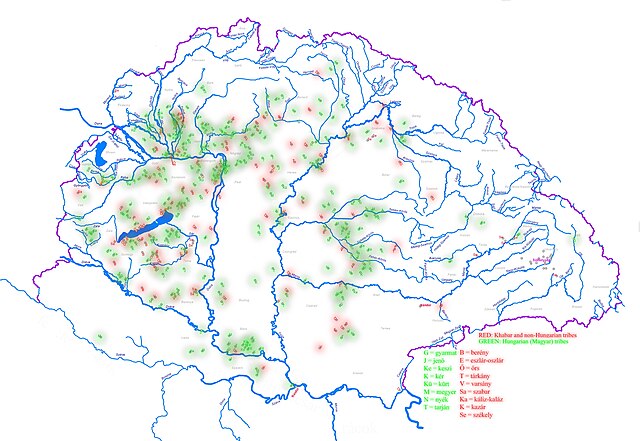Top Qs
Timeline
Chat
Perspective
Magyar tribes
Political units in the Hungarian tribal confederation From Wikipedia, the free encyclopedia
Remove ads
The Magyar or Hungarian tribes (/ˈmæɡjɑːr/ MAG-yar, Hungarian: magyar törzsek) or Hungarian clans were the fundamental political units within whose framework the Hungarians (Magyars) lived, before the Hungarian conquest of the Carpathian Basin and the subsequent establishment of the Principality of Hungary.[1][2]

Remove ads
Etymology
Summarize
Perspective
The origin of the term "Hungary", the ethnonym of the Hungarian tribal alliance, is uncertain. According to one view, following the description in the 13th-century chronicle, Gesta Hungarorum, the federation was called "Hetumoger" (modern Hungarian: hét magyar, lit. 'seven Magyars'), as in the Latin phrase, "VII principales persone qui Hetumoger dicuntur" ("seven princely persons who are called Seven Magyars").[3] The word "Magyar" possibly comes from the name of the most prominent Hungarian tribe, called Megyer, which became used to refer to the Hungarian people as a whole.[4][5][6] Written sources called Magyars "Hungarians" before the conquest of the Carpathian Basin when they still lived on the Pontic-Caspian Steppe. For example, Georgius Monachus used "Ungri" to refer to them in 837, the Annales Bertiniani used "Ungri" in 862, and the Annales ex Annalibus Iuvavensibus used "Ungari" in 881. The English term "Hungarian" is a derivative of these Latin forms.
Remove ads
History
Summarize
Perspective

According to Hungarian historian and linguist András Róna-Tas, the locality in which the Hungarians, the Manicha-Er group, emerged was between the Volga River and the Ural Mountains.[7] It is proposed that most of the early Hungarian tribes originated from the Volga-Kama and Southern Urals,[8] or the Southern Urals and Western Siberia, where they were composed of a mixed population.[9][10][11][12] Fóthi et al. 2022 suggests that they originated from three distinct regions on the Eurasian steppe: the Lake Baikal-Altai Mountains region, spanning present-day northwestern Mongolia and southern Siberia, the Southern Urals-Western Siberia and the Black Sea-Northern Caucasus.[13] Meanwhile, Neparáczki et al. 2018 proposes that over a third of the Hungarian conquerors’ maternal lineages derive from Inner Asia, concentrated in present-day eastern Mongolia and southeastern Siberia, while the remainder is derived from the Pontic-Caspian Steppe.[14]
According to genetic study, the proto-Ugric groups were part of the Scytho-Siberian societies in the late Bronze Age to early Iron Age steppe-forest zone in the northern Kazakhstan region, near of the Mezhovskaya culture territory. The ancestors of the Hungarian conquerors lived in the steppe zone during the Bronze Age together with the Mansis. During the Iron Age, the Mansis migrated northward, while the ancestor of Hungarian conquerors remained at the steppe-forest zone and admixed with the Sarmatians. Later the ancestors of the Hungarian conquerors admixed with the Huns, this admixture happened before the arrival of the Huns to the Volga region in 370. The Huns integrated local tribes east of the Urals, among them Sarmatians and the ancestors of the Hungarian conquerors.[15][16]
Around 830 CE, when Álmos, the future Grand Prince of the Hungarians, was about 10 years old, the seven related tribes (Jenő, Kér, Keszi, Kürt-Gyarmat, Megyer, Nyék, and Tarján) formed a confederation in Etelköz, called "Hétmagyar" (lit. 'Seven Magyars').[17][18][19] Their leaders, the Seven chieftains of the Magyars, besides Álmos, included Előd, Ond, Kond, Tas, Huba and Töhötöm, who all took a blood oath swearing eternal loyalty to Álmos.[20] Presumably, the Magyar tribes consisted of 108 clans.[21]
Before 881 CE, three Turkic tribes rebelled against the rule of the Khagan of the Khazars, but they were suppressed. After their defeat they left the Khazar Empire and voluntarily joined the Hétmagyar confederation. The three tribes were organised into one tribe, called Kabar, and later they played the roles of vanguard and rear guard during the joint military actions of the confederation. The joining of the three tribes to the previous seven created the On-ogur (Ten Arrows).[17]
Remove ads
Tribes
Hungarian chroniclers of the 13th century spoke of Magna Hungaria (modern Bashkortostan) and reported that speakers of Hungarian were located there. It is theorized that the Magyars and Bashkirs had close contact before the former's migration west, as there are many parallels between old Hungarian and Bashkir tribal names.[22] Furthermore, most of these names do not have such similarities with Central or Inner Asian languages, implying they may be a unique product of a local Bashkir-Magyar symbiosis.[23] Turkologists Gyula Neméth and Peter B. Golden have compared the following names to this end:
Social organization
The Hungarian social structure was of Turkic origin.[24]
Genetics
Magyars comprised seven clans, and later three more clans made of Kabar people. Recent genetic research has shown that the first-generation Magyar core gene pool originated in Central Asia/South Siberia and, as Magyars migrated westward, admixed with various European peoples and peoples of the Caucasus. Burial samples of the Karos-Eperjesszög Magyars place them genetically closest to Turkic peoples, modern south Caucasian peoples, and modern Western Europeans to a limited degree, while no specific Finno-Ugric markers were found.[25] However, a 2008 study done on 10th-century Magyar skeletons did find a few Uralic samples.[26]
Remove ads
See also
Sources
- Korai Magyar Történeti Lexikon (9-14. század), főszerkesztő: Kristó, Gyula, szerkesztők: Engel, Pál és Makk, Ferenc (Akadémiai Kiadó, Budapest, 1994)
- Kristó, Gyula: A Kárpát-medence és a magyarság régmúltja (1301-ig) (Szegedi Középkortörténeti Könyvtár, Szeged, 1993)
- Magyarország Történeti Kronológiája I. – A kezdetektől 1526-ig, főszerkesztő: Benda Kálmán (Akadémiai Kiadó, Budapest, 1981)
- Makkai, László (2001). Transylvania in the medieval Hungarian kingdom (896-1526), In: Béla Köpeczi, HISTORY OF TRANSYLVANIA Volume I. From the Beginnings to 1606, Columbia University Press, New York, 2001, ISBN 0880334797
Remove ads
References
Wikiwand - on
Seamless Wikipedia browsing. On steroids.
Remove ads
